How to Prevent Mold from Growing in Potted Plants
Mold is a type of fungus that thrives in warm and damp environments, making potted plants a prime breeding ground. Not only does mold look unsightly, but it can also be harmful to the plant and the people around it. Here are some tips on how to prevent mold from growing in potted plants:
1. Choose the Right Soil
The type of soil used in the pot can have a significant impact on the growth of mold. It is essential to choose a high-quality potting mix that is well-draining and aerated. The soil should allow excess water to drain out quickly and not retain too much moisture. This will prevent the soil from becoming a breeding ground for mold.
2. Water the Plants Correctly
Overwatering is one of the most common causes of mold growth in potted plants. To avoid this, ensure that you water the plant only when the top layer of soil feels dry to the touch. Don’t let the soil become waterlogged, and always ensure that excess water drains out of the pot. Use a saucer to catch any residual water and empty it out after a few minutes.
3. Proper Drainage
Poor drainage is another significant cause of mold growth in potted plants. Ensure that the pot has enough drainage holes to allow excess water to drain out. If the pot doesn’t have drainage holes, drill a few holes at the bottom to allow water to escape. Excess water in the pot promotes the growth of mold.
4. Keep the Plant Clean
Regular cleaning of the plant is essential to prevent the growth of mold. Dust and debris that accumulate on the leaves and stems can provide a breeding ground for mold. Wipe the leaves and stems with a damp cloth regularly to remove dirt and dust. Trim off any dead or yellow leaves and flowers to prevent the spread of mold to healthy parts of the plant.
5. Improve Air Circulation
Mold thrives in damp and stagnant environments. Improving air circulation around the plant can help prevent the growth of mold. Place the pot in a well-ventilated area and ensure that there is enough space around it for air to circulate. Open windows and doors to improve air flow in the room.
6. Use Fungicides
If mold growth is severe, you can consider using fungicides to control it. Fungicides usually come in the form of sprays or powders and can be used as per the instructions on the label. It is essential to use a fungicide that is safe for plants and follow the manufacturer's instructions carefully.
In conclusion, mold growth in potted plants is a common problem that can be prevented by choosing the right soil, watering correctly, providing proper drainage, keeping the plant clean, improving air circulation, and using fungicides when necessary. With these preventative measures, you can ensure that your potted plants are healthy and free from mold.

 how many times do yo...
how many times do yo... how many planted tre...
how many planted tre... how many pine trees ...
how many pine trees ... how many pecan trees...
how many pecan trees... how many plants comp...
how many plants comp... how many plants can ...
how many plants can ... how many plants and ...
how many plants and ... how many pepper plan...
how many pepper plan...
































